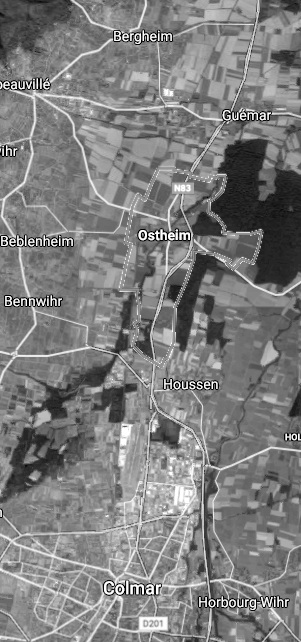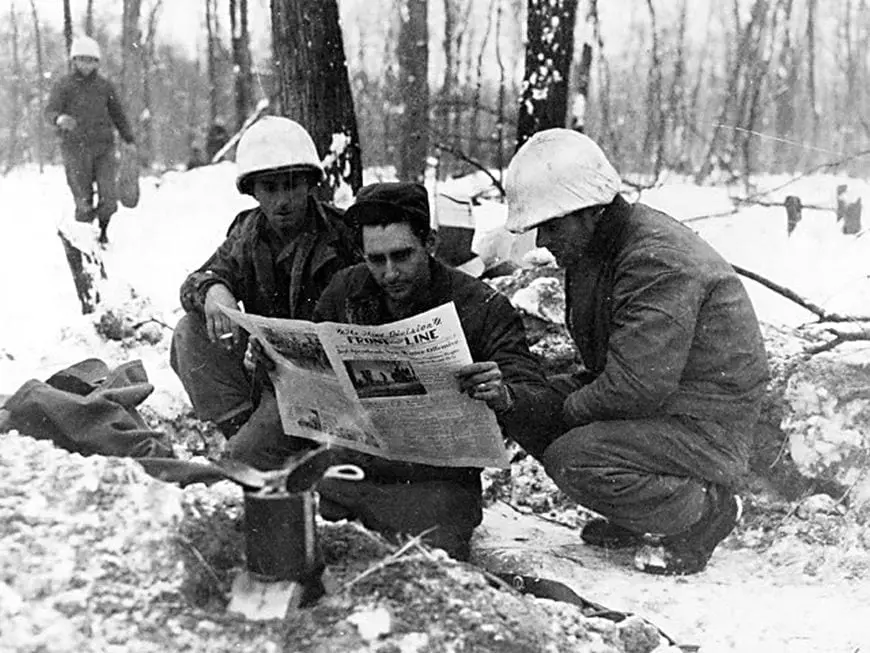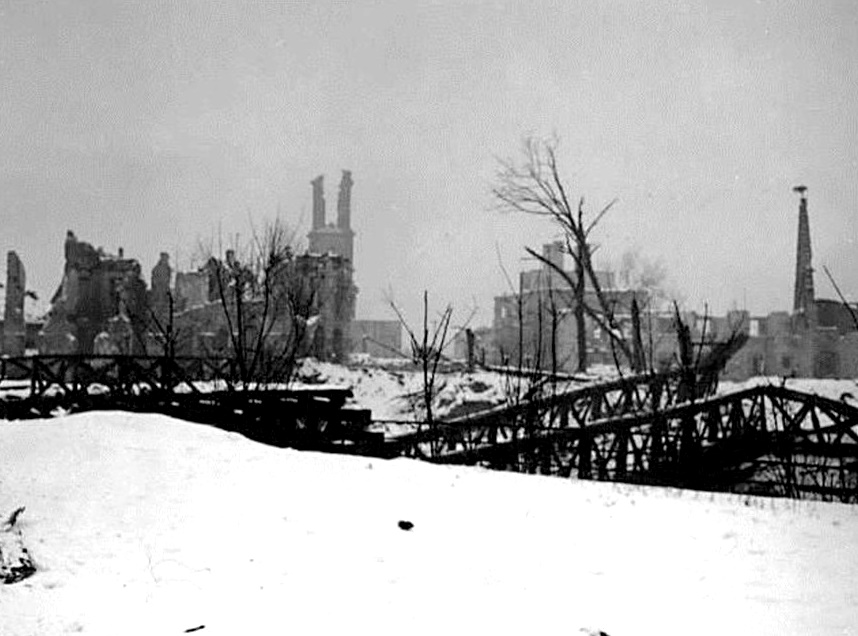Attack Plans – General Plan
The attack of the 3-ID was part of the combined efforts of all units under the control of the French 1-A to wipe out the German bridgehead in Colmar. Two main efforts were to be made. On Jan 20, 1945, the French I Corps was to open the assault with a thrust from the south, in the vicinity of Mulhouse. This operation was to be followed two days later by a night attack from the northwest, to be launched by the French II Corps, of which the American division was a part. The initial night assault in this last area would be followed the next morning by a new blow when the 1-ID (Morocco) pimped off in an attack against the northern flank of the pocket. The prongs of these thrusts, with the total weight of the French 1-A behind them, were aimed at Neuf-Brisach and the German supply escape routes across the Rhine River in the neighborhood of that town.
The 3-ID, in its sector, was ordered to force crossings of the Fecht and the Ill Rivers and then to pivot for a slash to the south across the Canal de Colmar, with (1) the view to isolate the city of Colmar itself and (2) to seize and hold important terrain features to the east of Colmar city, preparatory to a continued attack. The 7-IR and the 30-IR (3-ID) were selected as the assault regiments. Plans called for the 7-IR to force crossings of the Fecht River at Guémar and then to fight south towards Colmar city between the Fecht and the Ill Rivers, the regiment to keep its right flank on the Fecht, his left on the Ill River. The 30-IR, on the left flank of the division, likewise was to cross the Fecht at Guémar but would continue on east to the Ill River, which it was also to force. The 30-IR planned then to pivot to the right and sweep south, seizing assigned objectives in its zone. This, then, was the division plan of attack, the 7-IR to force crossings of the Fecht River at Guémar and pivot south, sweeping the area between the Fecht and the Ill Rivers the 30-IR to cross the Fecht River also and then to continue on east to the Ill River, which it would force and then turn to attack south.
7-IR Plan
 The attack of the 7-IR was an envelopment. All three of its battalions (initially two in the assault, one in reserve) were to cross the Fecht River at the same point (Guémar), where they would pierce and plunge through the German lines on a very narrow front. Once this penetration was made, the battalions were to the wheel to the right, deploy on line, and then roll south, crumpling the German winter defense line in an assault made upon that line’s flank and rear. During this operation, the regimental left flank would be protected by the Ill River, and by the 30-IR on the other bank of that stream, its right flank would be protected by the Fecht River. This was a simple plan, with obvious advantages in that powerhouse envelopment, which it was planned would roll down the German lines like a steel tape measure that was being wound up on its reel. But if the plan insured that the American regiment would smash into the German defenses from the flank, it also ensured that in the path of these same forces lay every enemy position, every enemy weapon, and every enemy soldier that had been placed on the eastern banks of the Fecht River in two months of defensive warfare. Men of the Easy Co were told that the number of the enemy would be about 400, a considerable underestimation, as events proved.
The attack of the 7-IR was an envelopment. All three of its battalions (initially two in the assault, one in reserve) were to cross the Fecht River at the same point (Guémar), where they would pierce and plunge through the German lines on a very narrow front. Once this penetration was made, the battalions were to the wheel to the right, deploy on line, and then roll south, crumpling the German winter defense line in an assault made upon that line’s flank and rear. During this operation, the regimental left flank would be protected by the Ill River, and by the 30-IR on the other bank of that stream, its right flank would be protected by the Fecht River. This was a simple plan, with obvious advantages in that powerhouse envelopment, which it was planned would roll down the German lines like a steel tape measure that was being wound up on its reel. But if the plan insured that the American regiment would smash into the German defenses from the flank, it also ensured that in the path of these same forces lay every enemy position, every enemy weapon, and every enemy soldier that had been placed on the eastern banks of the Fecht River in two months of defensive warfare. Men of the Easy Co were told that the number of the enemy would be about 400, a considerable underestimation, as events proved.
 The 1/7 and the 3/7 were designated assault units for the Fecht River crossing, which was scheduled for both battalions on the south edge of Guémar during the night of Jan 22-23. Prior to H-Hour, which was set at 2100, each of these battalions was to move one assault platoon across the river in order to seize and secure bridgeheads for the crossings and to furnish protection for the bridge-building parties from Able Co, 10-ECB. The engineers would erect two-foot bridges, (Red and Blue) and when these were computed, the 1/7 and the 3/7 were to cross the river and then attack south and south-east, the 1/7 to be the right battalion, with its flank on the Fecht, the 3/7 to be the left battalion, with its left flank on the Ill River. The attack was to be made by stealth. The 2/7, initially in reserve, was to cross the Fecht River on regimental order and attack south, taking its place in the center, between the other two battalions.
The 1/7 and the 3/7 were designated assault units for the Fecht River crossing, which was scheduled for both battalions on the south edge of Guémar during the night of Jan 22-23. Prior to H-Hour, which was set at 2100, each of these battalions was to move one assault platoon across the river in order to seize and secure bridgeheads for the crossings and to furnish protection for the bridge-building parties from Able Co, 10-ECB. The engineers would erect two-foot bridges, (Red and Blue) and when these were computed, the 1/7 and the 3/7 were to cross the river and then attack south and south-east, the 1/7 to be the right battalion, with its flank on the Fecht, the 3/7 to be the left battalion, with its left flank on the Ill River. The attack was to be made by stealth. The 2/7, initially in reserve, was to cross the Fecht River on regimental order and attack south, taking its place in the center, between the other two battalions.
The main objective for the 1/7 was the town of Ostheim. This was an important mission, inasmuch as Ostheim was to be the site for a vehicle bridge. Until Ostheim was secured and this bridge built, the fighting battalions would have no armored support in their ranks. After Ostheim was secured, the 1/7 was to send at least one company about three-quarters of a mile south, where this company was to set up a strong roadblock north of Château de Schoppenwihr. In this position, the 1/7’s company would (1) protect its own battalion from any enemy movement from the south and (2) protect the right flank of the 2/7 which would be passing through the Rothleible Wald (Rothleible Woods), just east of this roadblock.
The 2/7, once it was ordered to cross the Fecht River behind the 1/7 and the 3/7, was to attack south through the thickly wooded Colmar Forest to a point just east of Ostheim, where the forest ended. Here the battalion was to cross a flat, open plain and enter the Rothleible Woods, a long finger of new forest running south and southwest and comprising at this point the battalion’s zone of advance. When the southern edge of the Rothleible Forest was secured, the battalion was to have one company dig in and hold this position, while with the remainder of its forces it attacked west from the woods in order to take Château de Schoppenwihr from the rear. In its attack against the Château de Schoppenwihr, which was a known enemy stronghold, the battalion was to receive supporting fires from the 7th Infantry Battle Patrol and two medium tanks. These last forces were to be located in the vicinity of a railroad bridge crossing the Fecht River northwest of the Château de Schoppenwihr. Once the Château was stormed and taken, the 2/7 was to move south again, seizing Rosenkranz and certain important road junctions just outside the suburbs of the city of Colmar. The battalion was to organize these final positions against a possible enemy attack and also was to send strong combat patrols south into the outskirts of Colmar city itself.
The 3/7, one of the two original assault battalions in the crossing at Guémar, was to swing southeast through the Colmar Forest, seizing objectives in its zone. The route of the battalion carried it completely through the Colmar Forest, Brunnwald (a wooded area just east of the southern edge of the Rothleible Woods), the town of Houssen, and successive objectives to the south, until its final positions, like those of the 2/7, were just outside the suburbs of the city of Colmar. The 3/7 was to set up blocks against any enemy armored thrust from the city and also was to send strong combat patrols to the south. The battalion was responsible to the regimental commander for a report on all available crossings over the Ill River in its area, as well as for maintaining contact with the 30-IR on the left, on the far banks of the Ill. As can be seen from the information above, the three attacking battalions would have with them no armored support initially. The bridges at Guémar were footbridges only. The regiment intended to get its vehicles and armored support across the Fecht River at two points, the site at Ostheim and a second site between Rosenkranz and Sigolsheim (this being a position which was to be seized and secured by the Battle Patrol after the capture of the Château de Schoppenwihr. During the first phase of the night attack, the regimental forward CP was set up in Guémar, near the river. Other elements of the regimental command group were stationed at first in the town of Beblenheim, west of Ostheim. This latter group was moved eventually to the west banks of the Fecht River, in a part of the village of Ostheim on the friendly side of the river.



















